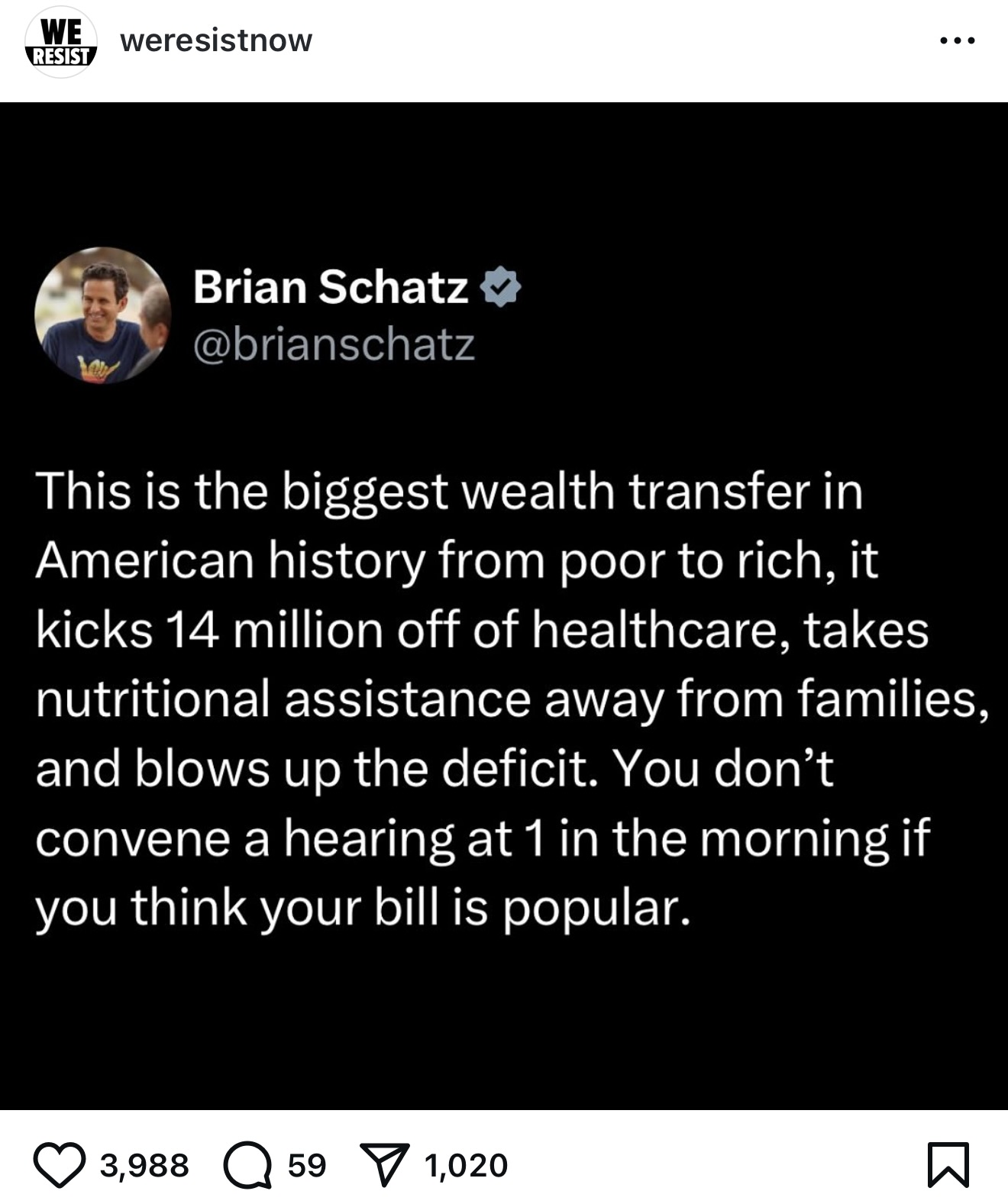The Cuts They Promised Would Never Come
“The Trump Administration will not cut Social Security, Medicare, or Medicaid benefits.”
—Donald J. Trump, March 11, 2025
This was the promise—delivered from podiums, press briefings, and campaign stages. Speaker Mike Johnson echoed it. So did Senate Finance Chair Mike Crapo and House Ways & Means Chair Jason Smith. “No cuts,” they said. “Zero.”
But the numbers don’t lie.
The FY2026 budget proposal slashes a combined $1.2 trillion from Medicare and Medicaid over 10 years. The result? Up to 10 million Americans losing coverage, the erosion of elder care protections, and the looming threat of automatic cuts to Medicare provider payments unless Congress intervenes.
Meanwhile, Social Security remains untouched—for now—but even it isn’t immune from administrative gutting and mounting fiscal pressure.
This blog breaks it all down: the promises, the math, and the quiet but massive transfer of wealth away from working families and toward the ultra-rich.
🧠 TL;DR
- “No cuts,” was the promise from Trump, Johnson, and GOP leaders.
- $500 billion in automatic Medicare cuts could begin in 2026 alone.
- $600–880 billion in Medicaid cuts could kick up to 10.3 million people off coverage.
- States pick up the slack—to the tune of $78 billion in new costs, mostly hitting blue states.
- Social Security spared for now, but agency gutting and long-term deficits suggest it’s next.
- The rich win again: more tax breaks, less accountability, and zero sacrifice.

Broken Promises: What They Said
They said they wouldn’t touch your benefits. Again and again. On national TV. In official statements. On social media.
Now, just weeks later, they’ve done the opposite—silently rewriting the social contract behind closed doors.
Quote Wall: Promises vs. Reality
March 11, 2025
“The Trump Administration will not cut Social Security, Medicare, or Medicaid benefits.”
March 11, 2025
“No cuts to Medicare, Medicaid, or Social Security. Zero.”
March 12, 2025
“We are committed to protecting retirement benefits seniors count on.”
March 25, 2025
“Absolutely clear… no reduction to benefits.”
Spoiler: Every one of these promises is now contradicted by the actual legislation and budget math.
They didn’t just go back on their word. They designed the budget to hide the cuts under technocratic language—“reforms,” “streamlining,” “federal savings,” and “PAYGO.” But when the Congressional Budget Office ran the numbers, the truth became impossible to deny:
Millions will lose coverage. Seniors will lose protections. And once again, the ultra-rich won’t lose a dime.
The Reality: What the FY2026 Budget Actually Does
Medicare: Up to $500 Billion in Cuts
Despite repeated promises, the FY2026 budget places Medicare squarely on the chopping block through both direct policy changes and automatic cuts triggered by deficit rules.
PAYGO Triggered: Automatic $500B Cuts to Medicare
Congressional Budget Office estimates show the FY2026 reconciliation bill increases the deficit by over $2.3 trillion. That triggers Statutory PAYGO, which mandates across-the-board cuts—except Medicare isn’t exempt.
Key Impact:
Unless Congress musters 60 votes to override PAYGO, Medicare will face $500 billion in cuts over the next decade, starting with $45 billion in 2026. These cuts include a 4% reduction to:
- Hospital reimbursements
- Physician fees
- Medicare Advantage plan payments
- Standalone prescription drug plans
Policy “Tweaks” That Add Up
Here’s how the reconciliation bill and budget compound the harm:
| Policy Change | Description | Projected Effect |
|---|---|---|
| Repeal of Nursing Home Staffing Rule | Removes federal mandate for minimum staffing in nursing homes. | Endangers seniors’ care standards. |
| Medicare Eligibility Rollback for Immigrants | Cuts coverage for lawful immigrants who’ve paid into the system. | Loss of Medicare and ACA subsidies. |
| Streamlined Enrollment Repealed | Ends modernization of enrollment for low-income seniors. | 1.4 million may lose cost-sharing support (e.g., help with premiums). |
| Physician Payment Reform | Ties increases to 10–75% of the Medicare Economic Index, not full inflation. | Slower growth in physician reimbursement. |
| Medicare APM Incentives | Larger increases for doctors using alternative payment models. | Prioritizes cost-saving model over access. |
Bottom line:
The cuts don’t just hit “fraud and waste.” They gut protections and shift costs onto seniors, immigrants, and providers—while letting wealthier stakeholders remain untouched.
Medicaid: The Biggest Cuts in U.S. History
Medicaid takes the deepest hit under the FY2026 budget—between $600 and $880 billion in cuts over 10 years.
These aren’t just trims. They’re structural overhauls that threaten to strip health coverage from up to 10.3 million people, while forcing states to absorb billions in new costs.
What’s Getting Cut and How
| Policy Change | Description | Impact |
|---|---|---|
| Work Requirements | Requires most adults 19–64 to work 80 hrs/month or prove exemption. | Millions may lose coverage due to paperwork, not actual employment status. |
| Federal Match Cuts (FMAP) | Slashes federal share for expansion states and lawful immigrants. | States shoulder more cost; cuts to education or safety net likely follow. |
| Increased Cost-Sharing | Allows states to charge up to $35 per visit. | Discourages care; hits working poor the hardest. |
| Immigrant Restrictions | Cuts eligibility for many lawful residents; limits retroactive coverage. | Legal residents lose safety net they’ve paid into. |
| More Frequent Eligibility Checks | Requires states to verify income and status at least 2x/year. | Administrative churn leads to disenrollment and gaps in coverage. |
| Long-Term Care Undermined | Caps Medicaid state payments below Medicare rates. | Threatens nursing homes, disability care, and home-based services. |
State Burden and the Domino Effect
States could face up to $78 billion in added costs. Most can’t or won’t cover the shortfall—especially during recessions when Medicaid rolls grow and state revenues fall.
This means:
- Cuts to schools, public safety, and transit
- Higher uninsured rates
- Emergency rooms overwhelmed by preventable crises
And all of it—engineered by design.

Social Security: Protected—For Now?
Social Security escapes direct cuts in the FY2026 budget. But don’t mistake that for safety.
What’s happening instead? Restructuring. Downsizing. Slow bleed.
The White House and GOP leaders claim they’re “protecting” Social Security, while simultaneously slashing budgets for frontline services, outsourcing operations, and introducing AI automation at the expense of human access.
What They’re Doing
| Change | Description | Hidden Impact |
|---|---|---|
| No Direct Benefit Cuts | Social Security remains exempt from PAYGO. | For now, checks are safe—but structural changes begin. |
| SSA Staffing Cuts | Reduces field office and phone support. | Longer wait times, slower processing, more errors. |
| Tech & AI Overhaul | Pushes digital-only services and automation. | Disproportionately hurts seniors, rural, and disabled populations. |
| Office Closures | Shutters SSA offices in “low-use” regions. | Access deserts for those without broadband or transport. |

Who’s Protected vs. Who’s Targeted
| Program | PAYGO Status | Budget Cuts | Restructuring | Risk Level |
|---|---|---|---|---|
| Social Security | ✅ Exempt | ❌ No direct cuts | ⚠️ Admin downsizing | 🟡 Medium (future pressure) |
| Medicare | ❌ Not exempt | ✅ Up to $500B | ✅ Staffing repeal, eligibility rollback | 🔴 High |
| Medicaid | ❌ Not exempt (indirect via reconciliation) | ✅ $600–880B | ✅ Work rules, cost-shifting | 🔴 Highest |
A Long-Term Warning
While Social Security is protected from this year’s cuts, its funding future isn’t secure:
- Trust Fund depletion looms by the mid-2030s without new revenue
- Current budget expands the deficit by $2.3 trillion, making pressure on entitlements inevitable
- If Medicare and Medicaid are already being gutted, Social Security may simply be next

Follow the Money: Wealth Up, Pain Down
If this budget is about “fiscal responsibility,” the math doesn’t show it.
The same bill that cuts healthcare for millions balloons the federal deficit by $2.3 trillion. But the pain isn’t spread equally.
While Medicare and Medicaid get gutted, spending explodes elsewhere:
- $1 trillion for the Pentagon
- $175 billion for Homeland Security
- $0 for protecting vulnerable seniors and hospitals
At the same time, the GOP quietly renewed corporate tax loopholes and capital gains exemptions—transferring billions to the top 1%.
Austerity for You, Abundance for Them
| Budget Item | Net Change | Who Benefits |
|---|---|---|
| Medicare | –$500B (automatic PAYGO cuts) | Wealthy investors in private insurance (Medicare Advantage margins protected) |
| Medicaid | –$600–880B | Budget savings reallocated to cover tax breaks |
| Defense Spending | +$115B increase | Military contractors, surveillance firms |
| Homeland Security | +$27B increase | Border wall expansion, ICE enforcement, detention |
| Corporate Tax Cuts | Renewed & expanded | Billionaires, hedge funds, pass-through LLCs |

Structural Upward Redistribution
This isn’t just about budget lines—it’s about intent.
- Healthcare cuts disproportionately hit seniors, immigrants, and working-class Americans
- Wealth gains go to the top 0.1% through capital gains, business pass-throughs, and corporate relief
- State burdens grow, while federal protections vanish
This is what economists call a regressive fiscal policy—but what millions of Americans will feel is simple:
“I lost my coverage. They got another yacht.”
Who’s Telling the Truth?
It’s one thing to make a promise. It’s another to vote against it.
Let’s match their words to their actions—line by line.
| Speaker | What They Said | What They Did |
|---|---|---|
| Mike Johnson | “No cuts to Medicaid.” | Voted for budget slashing $700B from Medicaid, including mandatory work requirements. |
| Donald Trump | “Medicare will not be cut.” | Signed off on a budget that triggers $500B in automatic PAYGO Medicare cuts. |
| Jason Smith | “We are protecting benefits seniors count on.” | Helped advance repeal of Nursing Home Staffing Rule and streamlined cost-sharing enrollment. |
| Mike Crapo | “Absolutely no reduction to benefits.” | Supported reconciliation bill shifting costs to states and cutting ACA credits. |

The Disinformation Playbook
The FY2026 budget uses euphemisms to mask the truth:
- “Streamlining enrollment” → kicking people off
- “Reforms to promote work” → paperwork traps
- “Savings from program integrity” → service closures and fewer staff
- “Not touching benefits” → shifting all costs to states, insurers, and patients
When the math exposes the message, language becomes a weapon.

What You Can Do
The cuts are real. The consequences are immediate. But the fight isn’t over.
Here’s how you can push back:
- Start prepping now. Make sure your paperwork is airtight. Help older family members and neighbors do the same.
- Call Congress. Name names. Use this blog as your script.
- Share this post. Make the truth go viral before the budget does more damage.
- Organize locally. Cuts to Medicaid don’t just affect individuals—they devastate hospitals, clinics, and care workers.
Local Action = National Impact
If your hospital closes or your mom loses coverage, it won’t be because of some distant “federal realignment.” It’ll be because of this budget. And unless people speak out—loudly—that impact will only grow.
Call your representatives. Email them. Show up at their town halls.
Let them know: We heard what you promised. We see what you’re doing. We vote.
The best defense for your family’s future is the truth. And now you’ve got it.
Sources
This blog is backed by public records, nonpartisan budget analyses, and Congressional documents. Here are the two primary source files:
- Specific and Documented Impacts on Medicare, Medicaid, and Social Security Under the FY2026 Budget (PDF)
- Public Assurances by Conservative Figures on Medicare, Medicaid, and Social Security Since Oct 1, 2024 (PDF)
Key external sources include:
- House Reconciliation Bill Could Trigger $500 Billion in Medicare Cuts – KFF
- The House Republicans’ Budget Bill Guts Basic Needs Programs – Center for American Progress
- President’s FY 2026 Budget Proposes Significant HHS Cuts – ASRS
- Fiscal-Year-2026 Discretionary Budget Request – White House PDF
- The Missing Puzzle Pieces of the FY 2026 “Skinny” President’s Budget – McDermott+
For additional reference, download and read the full CBO analysis, budget resolution markup, and hearing transcripts linked in the footnotes of our source PDFs.
If you cite this blog, please link directly to the permalink: /2025/fy2026-benefit-cuts-lies





Leave a comment